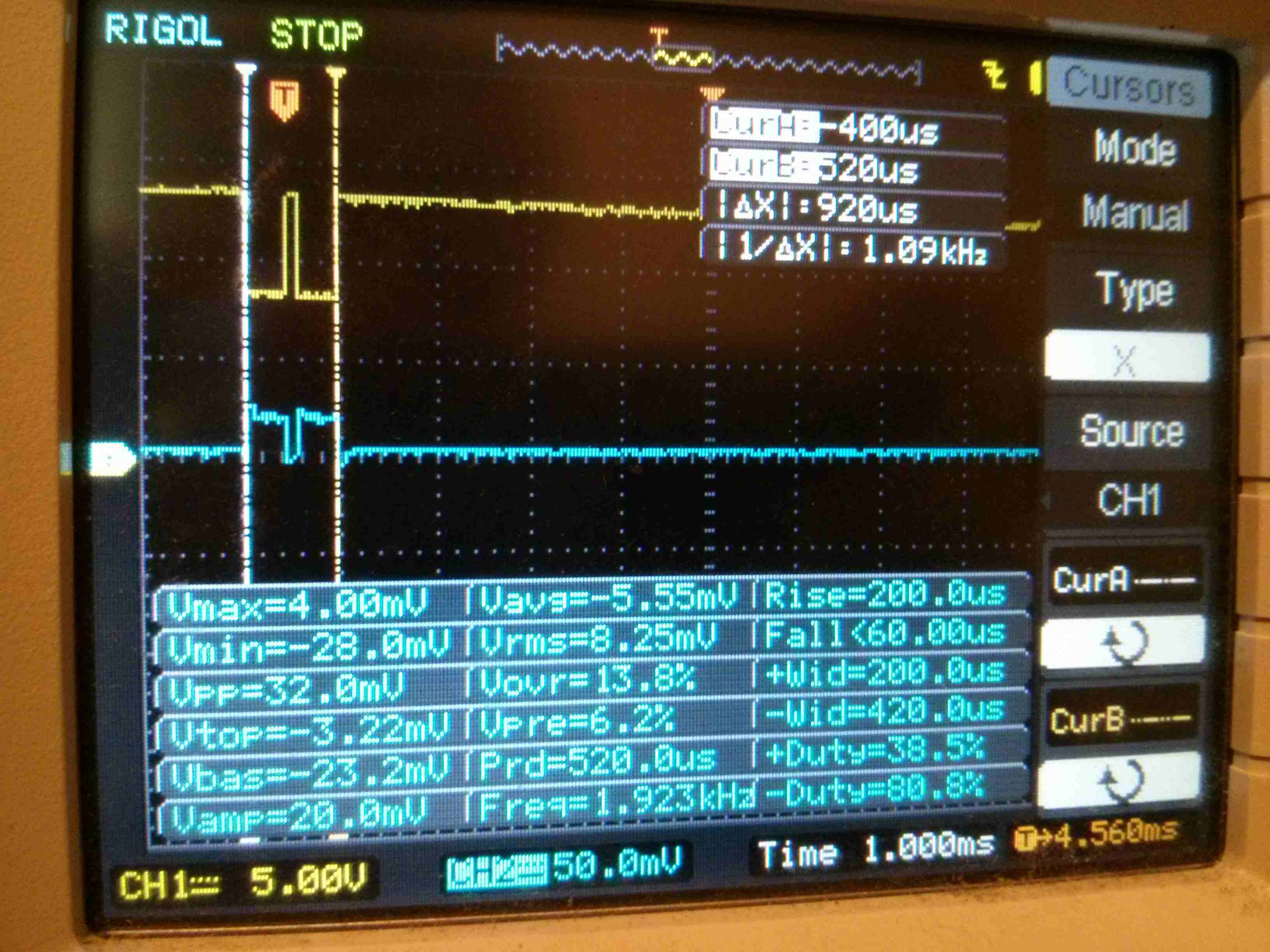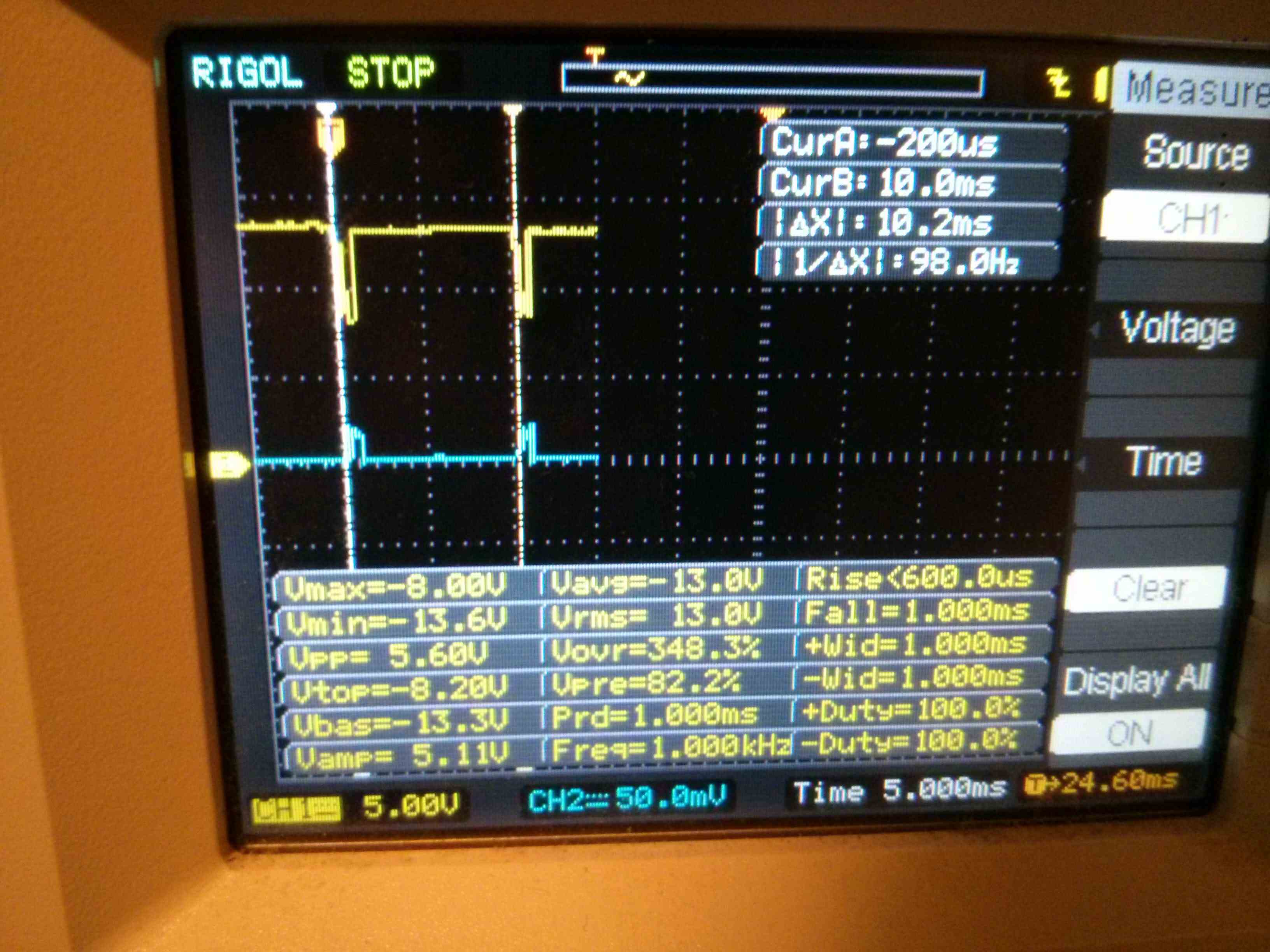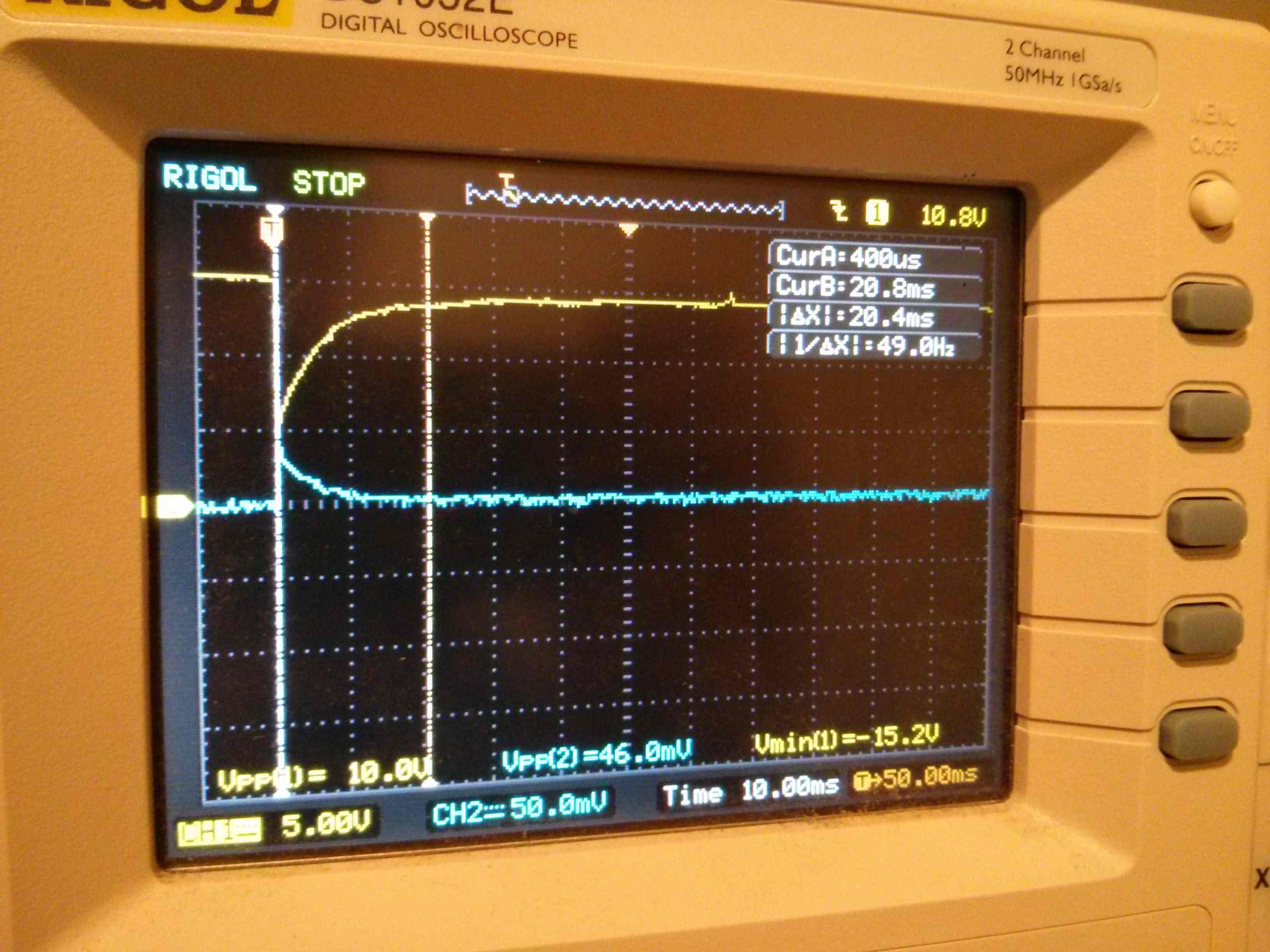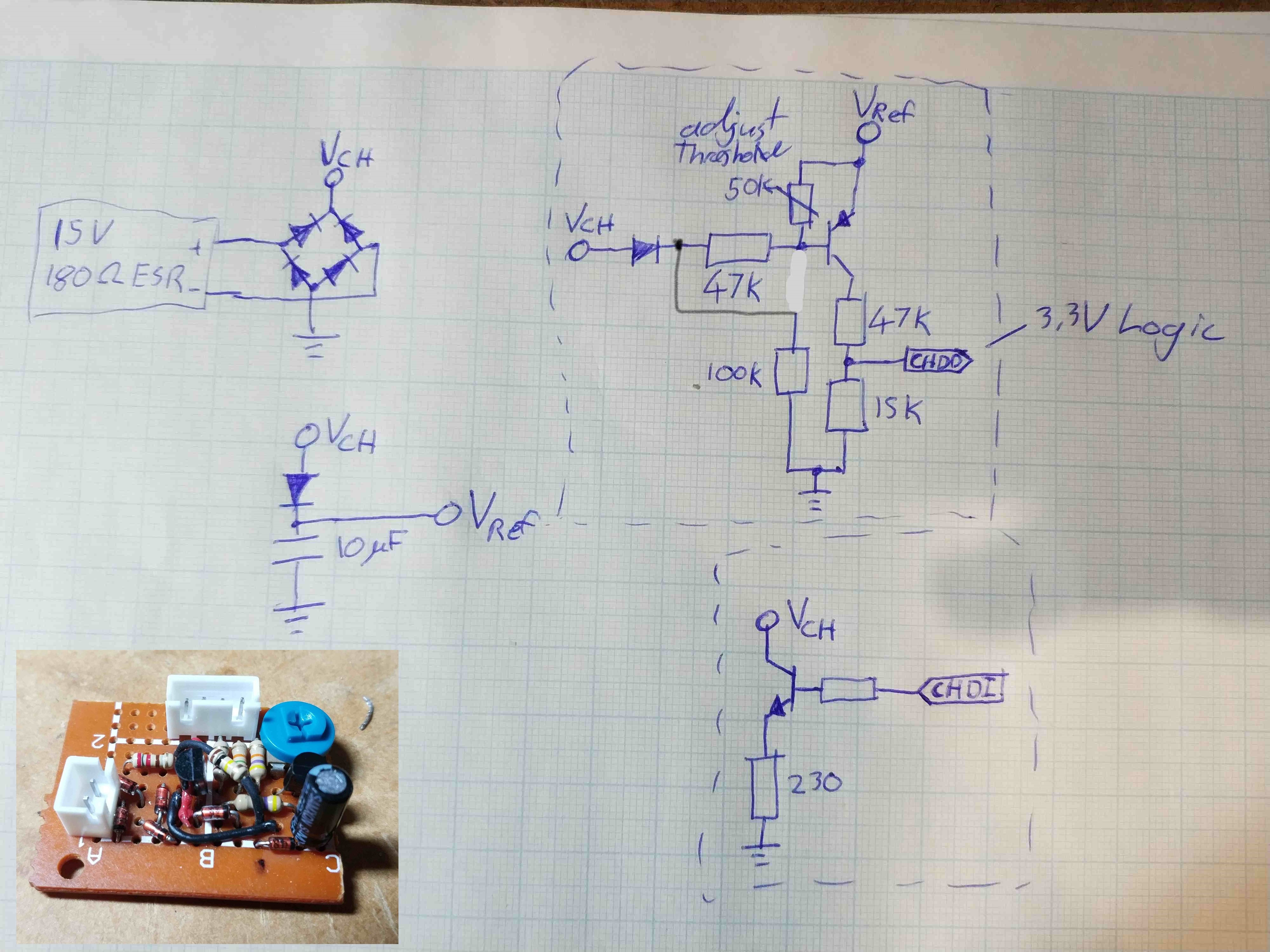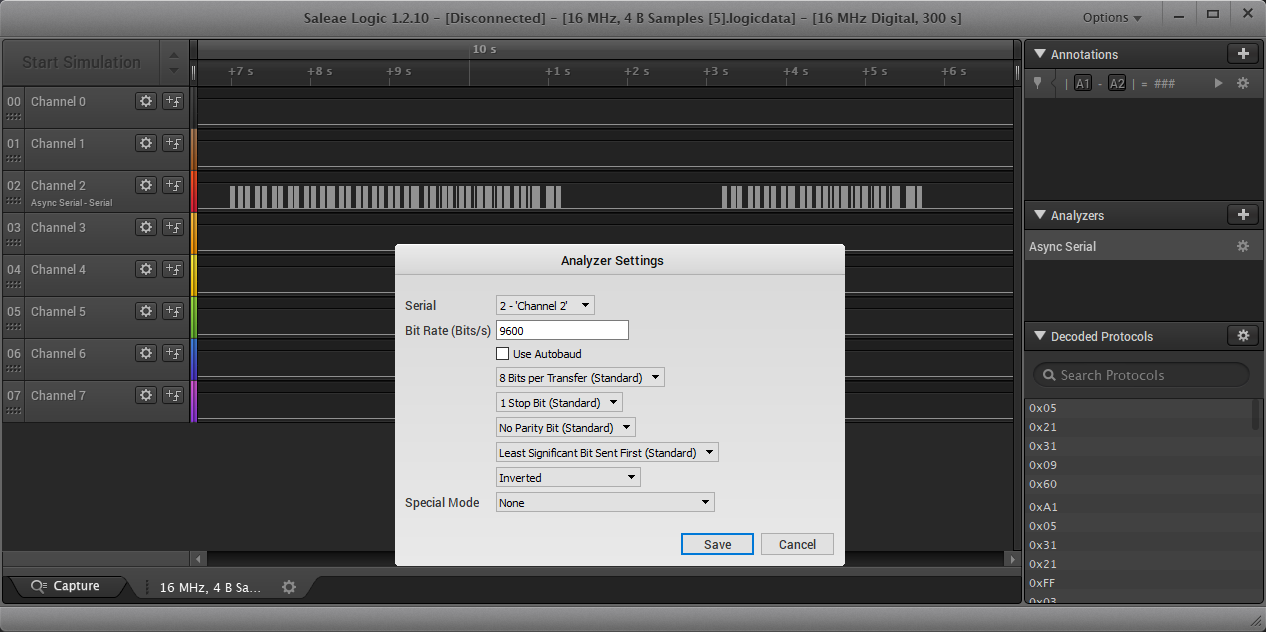Reverse Engineering the Brivis 1-Wire Protocol
Writeup of the protocol can be found in protocol.md
Motive
Wanting to automate existing systems in my house and we havea Brivis Central heating unit. Although it has a timer, it's not very practical when everyone in the house doen't live with a fixed schedule and the weather changes.
Ideally, we can interact with the control panel to turn on and off using a system such as If This Then That to automate multiple home appliaces together.
Preliminary
The control panel accepts two wires, that immediately pass through a full bridge rectifier. This appears to make installation easier as the signal is 15V DC so to allow reverse polarity.
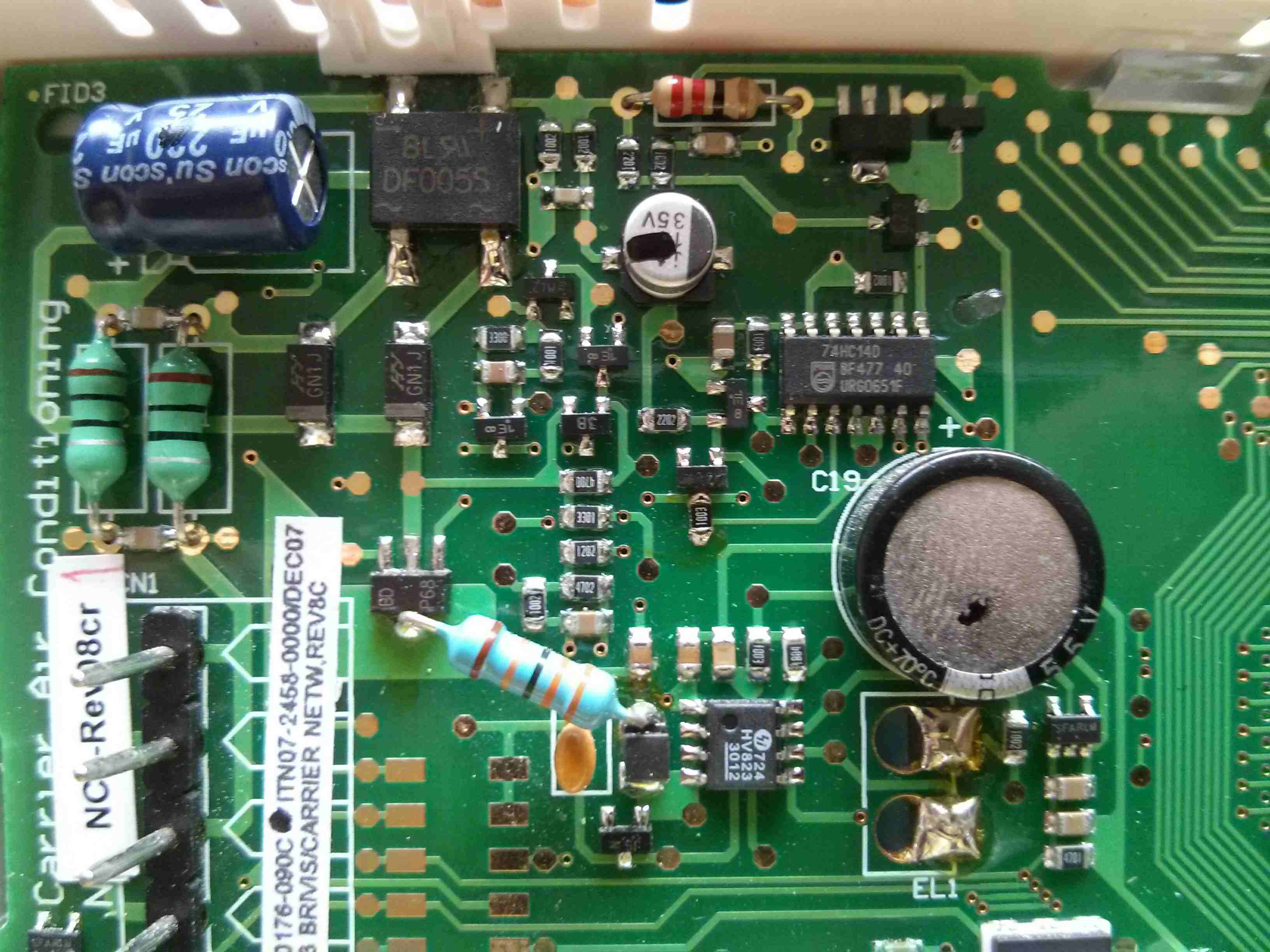
Measuring the signal with a scope, the voltage drops down to 13.6V when the panel is connected, and to a further 8V during data transmission. Typical current draw when data is transmitted is 20mA (8V / 20mA = 400Ω)
Manually testing a 220Ω resistor pulls the voltage back down to 8V, shows tha the system as a 180Ω effective series resistance.
When the panel is plugged in and powered on, it draws power for about 20ms (charing up it's own capacitor). Then settles to about 4mA.
Using a circuit that holds a reference voltage of the system at rest and operates an output signal as the input voltage drops below a threshold, a logic analyser can be used to collect data for long periods of time. For example, using a fx2la based logic analyser such as Saleae Logic, we can capture data for long periods of time.
After capturing the raw signals, a UART protocol decoder is used configured with a 9600 baudrate and inverted signal gives us clean hex data that we can work with.
Analysis
Each byte in a payload is transmitted at 10ms intervals, with about 50ms in between payloads.
Here is a dump of the payloads with their respective timestamp during a single session.
6.99 | 05 21 31 09 60 A1 // Turning the knob to increment the set temperature
7.10 | 05 31 21 FF 03 D5
7.18 | 05 21 31 09 60 A1
7.31 | 05 31 21 FF 03 D5
7.39 | 05 21 31 09 60 A1
7.52 | 05 31 21 FF 03 D5
7.60 | 05 21 31 09 60 A1
7.72 | 05 31 21 FF 03 D5
7.80 | 05 21 31 09 60 A1
7.92 | 05 31 21 FF 03 D5
8.01 | 05 21 31 09 60 A1
8.13 | 05 31 21 FF 03 D5
8.22 | 08 21 31 0B 00 0E 23 40 93 // The set temperature is now greater than the current temperature of the panel
8.37 | 05 31 21 FF 03 D5
8.46 | 05 21 31 09 60 A1
8.58 | 05 31 21 FF 03 D5
8.67 | 05 21 31 09 60 A1
8.78 | 05 31 21 FF 03 D5
8.87 | 05 21 31 09 60 A1
8.98 | 05 31 21 FF 03 D5
9.07 | 05 21 31 09 60 A1
9.19 | 05 31 21 FF 03 D5
9.27 | 08 21 31 0B FF 14 23 90 9C // The heating system shows the fan is active and the gas heating element is on.
9.43 | 05 31 21 FF 03 D5
9.51 | 06 21 31 29 00 E0 CB
9.62 | 09
9.66 | 05 31 21 FF 03 D5
9.74 | 05 21 31 09 60 A1
9.84 | 09
9.88 | 05 31 21 FF 03 D5
9.97 | 05 21 31 09 60 A1
10.07 | 09
10.11 | 05 31 21 FF 03 D5
10.20 | 08 21 31 0B FF 16 23 1C 9F
10.32 | 09
10.36 | 05 31 21 FF 03 D5
10.45 | 06 21 31 29 00 E0 CB
10.57 | 05 31 21 FF 03 D5
10.66 | 05 21 31 06 60 83
10.75 | 09 31
10.80 | 09 31 21 FB 00 22 00 00 F1 64
10.97 | 09 31 21 05 00 22 00 00 59 37
11.10 | 05 21 31 FF 62 95
13.20 | 05 21 31 09 60 A1 // Turning the knob to decrement the set temperature
13.31 | 05 31 21 FF 03 D5
13.39 | 05 21 31 09 60 A1
13.52 | 05 31 21 FF 03 D5
13.61 | 05 21 31 09 60 A1
13.73 | 05 31 21 FF 03 D5
13.82 | 05 21 31 09 60 A1
13.94 | 05 31 21 FF 03 D5
14.03 | 08 21 31 0B 00 0D 23 4A 93
14.18 | 05 31 21 FF 03 D5
14.27 | 05 21 31 09 60 A1
14.38 | 05 31 21 FF 03 D5
14.47 | 05 21 31 09 60 A1
14.56 | 09 31
14.61 | 05 31 21 FF 03 D5
14.70 | 08 21 31 0B 00 00 23 E4 90
14.82 | 09 31
14.87 | 05 31 21 FF 03 D5
14.96 | 06 21 31 29 00 E0 CB
15.07 | 09
15.11 | 05 31 21 FF 03 D5
15.20 | 05 21 31 06 60 83
15.31 | 09
15.34 | 09 31 21 FB 00 00 00 00 F3 CC
15.52 | 09 31 21 05 00 00 00 00 5B 9F
15.65 | 05 21 31 FF 62 95
A ESP32 UARTLogger was used as a simple data logger. By reading serial data via UART and sending the packets to a simple HTTP server which then timestamps the request and saves it to a log file (logfile.2018-04-15.txt).
The messages appear to start with a length byte as the following number of bytes match. Based on randomness (or high entropy) the last two bytes could be CRC 16.
Reveng is a neat utility to try and guess your CRC parameters. Using a random message captured from the log. We get
$ reveng -w 16 -s 082131070a05068ac5
width=16 poly=0x8005 init=0x0000 refin=false refout=false xorout=0x0000 check=0xfee8 residue=0x0000 name="CRC-16/BUYPASS"Which proves the last two bytes are CRC16 using CRC-16/BUYPASS
Extracting the message by (removing the first byte(the length) and the last 2 bytes(the CRC) yields a message where bytes:
- The source device's address
- The destination device's address
- An opcode?(message in this context means the remaining bytes)
- Heater
01-- Appears to be a ping. Sent to increasing addresses after removing the controller. No message body.FF-- Appears to be heater "ack". No message bodyFB-- Appears to be status reporting. Message is 4 bytes.
- Controller
06-- Appears to be status request. (Heater respondsFB). No message body.07-- Time/Day of Week. (1ce/min). (Aked by heater withFF). 3 byte message body:- Hour of day(e.g.
0x16==22:xx) - Minute of hour(e.g.
0x24==xx:36) - Day of week(Monday ==
0x00, Sunday ==0x06).
- Hour of day(e.g.
09-- ???. (1ce/min). (Aked by heater withFF). No message body.0b-- Temperature control (1ce/min). (Aked by heater withFF). 3 byte message body:- State of something? (remains
0x00for most of the day.0xffhas been seen). - Target temperature(e.g.
0x11==17 deg C).0x00is "off". - Current temperature times 2(e.g.
0x25==18.5 deg C).
- State of something? (remains
29-- ???. (1ce/min). (Aked by heater withFF). 1 byte message body:00-- ?
- Heater
